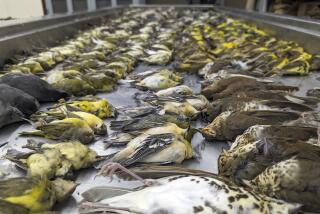Data Link Bird Decline to Exotic Shrubs
- Share via
LISLE, Ill. — Christopher Whelan peers through the arching branches of the wild honeysuckle and points to a confluence of limbs about three feet above the ground.
To an unsuspecting bird, the strong, V-shaped crotch is the perfect spot to build a nest. To Whelan, an avian ecologist at the Illinois Natural History Survey, the harmless-looking bush is a trap.
In a study that adds a new twist to concerns about how nonnative, or exotic, species affect ecosystems, Whelan and Kenneth Schmidt, a researcher at the University of Memphis, suggest the proliferation of exotic shrubs may be contributing to declining songbird populations.
Analyzing six years of data collected from 585 American robin and wood thrush nests in the 1,600-acre Morton Arboretum near Chicago, Whelan and Schmidt discovered birds that nested in exotic honeysuckle and buckthorn were almost never able to fledge young before the nests were destroyed or raided by other animals.
The reason? The nonnative bushes don’t protect nests as well as native shrubs, the pair said.
The honeysuckle’s stronger branches, for example, encourage birds to build their nests lower than normal, putting them within easy reach of hungry marauders such as raccoons, and also support the predators’ weight. And, unlike the native hawthorn, buckthorn doesn’t have thorns to protect nests, researchers said.
Moreover, because of the exotic shrubs’ aggressive growing traits and the destruction of native habitats due to development, the honeysuckle has largely replaced the native arrowwood and the buckthorn has crowded out the hawthorn--leaving birds with fewer nesting choices.
But even when birds did have a choice, they increasingly built their nests in the exotic shrubs, which tend to leaf out earlier than native shrubs, researchers said. In six years, for example, the number of robins nesting in honeysuckle increased sixfold, from 5% to more than 30%. Wood thrushes chose exotic shrubs about half the time.
The results were not pretty, Whelan and Schmidt said. “[The nests] were getting clobbered, for the most part,” Schmidt said.
Whelan and Schmidt go on to pose a potentially alarming question: What if the same scenario is playing out unnoticed throughout the range of the exotic shrubs-- from the Atlantic Seaboard to the Rocky Mountains and from Nova Scotia to Virginia? If so, the future of birds nesting in those shrubs is “pretty grim,” Whelan said.
“If exotics have invaded to the same extent throughout their whole geographical range as they have in Chicago and the Midwest, and if birds are using them the way they’re using them around here, my guess is it’s a big problem,” he said.
He and Schmidt say more study is needed to prove their theory, but their research, published in the December issue of Conservation Biology, has created some ripples in the world of ornithology.
Wesley Hochachka, assistant director of bird population studies at the Cornell Laboratory of Ornithology, said he’s not convinced, but the idea merits study.
“It’s an interesting and important enough suggestion,” he said. “Honeysuckle and buckthorn are prevalent enough in Northeastern and Midwest states that it would be important to notice if that had negative effects on songbirds.”
It is difficult to determine the extent to which exotic shrubs may be contributing to declines in bird populations compared with known problems such as pollution and habitat destruction. Many species of birds are not doing well in Illinois because of the destruction of tall-grass prairies and deciduous forests, Hochachka said.
The wood thrush population in Illinois declined almost 3% a year between 1966 and 1998, said John R. Sauer of the U.S. Geological Survey. But robin populations increased about the same amount during the same period, he said.
Whelan said research showed neither robin nor wood thrush nests fare well in exotic shrubs. But when a robin’s nest is destroyed in an exotic bush, it usually builds the next nest in a native tree, while the wood thrush will continue to build subsequent nests in exotic shrubs.
Scott Robinson, head of the University of Illinois’ department of ecology, ethology and evolution, said Schmidt and Whelan’s study may boost efforts to restore native plants. “Some people always assumed that if birds were nesting in a habitat, it must be good habitat,” he said. “But some habitats are inappropriate.”
More to Read
Sign up for Essential California
The most important California stories and recommendations in your inbox every morning.
You may occasionally receive promotional content from the Los Angeles Times.













